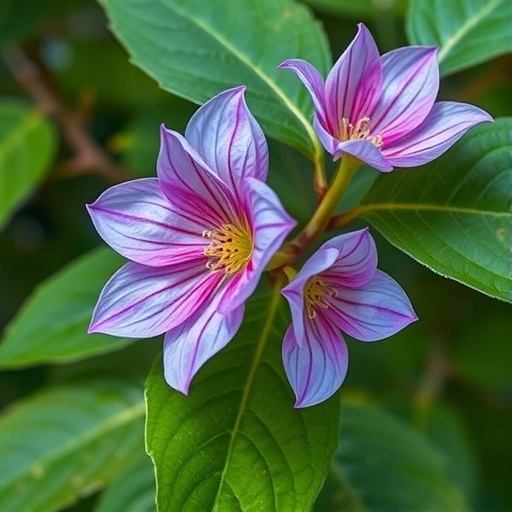In recent years, the search for natural compounds that can influence neurological function has intensified, especially those capable of modulating the brain’s intricate neurotransmitter systems. A groundbreaking study published in Food Science and Biotechnology unveils compelling evidence highlighting the neuromodulatory effects of Pueraria lobata roots and its primary bioactive constituent, puerarin, on the dopamine system. This discovery could herald a new era in neurotherapeutics, offering promising avenues for addressing neurological and psychiatric disorders linked to dopamine dysregulation.
Pueraria lobata, commonly known as kudzu, is a leguminous plant long revered in traditional Eastern medicine for its therapeutic properties, particularly in cardiovascular and liver health. However, its potential influence on the central nervous system has remained relatively underexplored until now. The study, conducted by Kim, Choo, Choi, and colleagues, dives deep into the biochemical interactions governing the dopaminergic pathways, shedding light on how root extracts and puerarin modulate dopamine transmission and receptor activity.
Dopamine functions as a critical neurotransmitter, regulating an array of physiological processes including motor control, motivation, reward, and cognitive functions. Dysfunctions in the dopaminergic system are implicated in several debilitating conditions such as Parkinson’s disease, schizophrenia, addiction, and major depressive disorder. Therefore, agents capable of fine-tuning dopamine signaling hold immense therapeutic value. The research assesses whether Pueraria lobata extracts can exert a regulatory effect on dopamine concentrations and dopamine receptor responsiveness in neuronal models.
Methodologically, the investigation employs a combination of in vitro cellular assays and in vivo rodent models to elucidate the neuromodulatory profile of puerarin. High-performance liquid chromatography (HPLC) coupled with electrochemical detection was utilized to measure dopamine levels with high precision. Additionally, receptor binding assays and electrophysiological studies enabled the team to evaluate the interaction dynamics of puerarin with dopamine receptor subtypes, particularly D1 and D2 receptors, which are critical in mediating dopamine’s neuromodulatory functions.
The findings reveal that Pueraria lobata root extracts significantly increase extracellular dopamine levels in targeted brain regions associated with mood regulation and reward processing. This elevation appears to be mediated by puerarin’s inhibition of dopamine reuptake transporters, resulting in prolonged dopaminergic synaptic activity. Concurrently, puerarin demonstrates agonistic activity on D2-like receptors, enhancing the receptor’s efficacy and potentially facilitating improved synaptic plasticity. These dual actions underline the compound’s capacity to balance dopamine signaling intricately.
An intriguing aspect of the study is puerarin’s selective modulation; while it amplifies dopamine signaling where deficient, it does not induce excessive dopamine release that could precipitate neurotoxic effects. This contrasts with certain pharmacological agents currently used in treating dopamine-related disorders, which often come with the risk of overstimulation and side effects such as dyskinesia or psychosis. Therefore, puerarin’s nuanced mechanism offers a safer therapeutic profile with fewer adverse outcomes.
The broader implications of these results extend beyond neuromodulation alone. Since the dopaminergic system intricately overlaps with other neurotransmitter networks like glutamate and GABA, the influence of Pueraria lobata and puerarin potentially affects neural circuitry at multiple levels. The researchers observed preliminary evidence suggesting that puerarin might also modulate glutamatergic synapses, hinting at a multi-faceted neuroprotective effect that could benefit neurodegenerative conditions characterized by excitotoxicity.
Explorations into the molecular pathways involved revealed that puerarin activates intracellular signaling cascades such as the cyclic AMP (cAMP)/protein kinase A (PKA) pathway, which is vital for synaptic modulation and neuronal survival. Furthermore, upregulation of brain-derived neurotrophic factor (BDNF) expression was noted, implying that puerarin could facilitate neurogenesis and synaptic resilience, two critical factors in maintaining cognitive function during aging or in disease states.
Clinical translation remains the ultimate goal. While the research is still primarily in preclinical stages, the potency and specificity of puerarin’s neuromodulatory effects encourage further investigation into its applicability as a novel adjunct therapy for dopamine-deficiency diseases. The natural origin of puerarin also enhances its appeal regarding patient compliance and reduced systemic toxicity compared to synthetic pharmaceuticals.
Additionally, the importance of dose optimization cannot be overstated. The researchers underscore that while puerarin exhibits beneficial effects at moderate concentrations, its pharmacodynamics at higher doses require thorough scrutiny to avoid potential off-target actions. The pharmacokinetics profile indicates good blood-brain barrier permeability, ensuring efficient central nervous system bioavailability, a critical factor when considering oral therapeutic formulations.
Public interest in botanical supplements has surged, often outpacing rigorous scientific validation. This study exemplifies a pivotal step toward evidence-based integration of traditional botanical agents in modern medicine. The convergence of ethnomedicine knowledge with cutting-edge neurobiological techniques epitomizes a promising frontier in neuroscience research and therapeutic innovation.
Experts not directly involved in the study have lauded these findings for their methodological robustness and potential impact. Dr. Amelia Richards, a neuropharmacologist, commented that “discovering natural compounds capable of fine-tuning the dopamine system provides a fresh perspective on how we approach neuropsychiatric treatment paradigms. The dual action of puerarin is particularly exciting as it suggests multifaceted modulation without the heavy side-effect profiles seen in current drugs.”
Further research is warranted to delineate the full spectrum of puerarin’s interactions with neurochemical systems and its long-term effects in chronic treatment models. Randomized clinical trials will be essential to establish efficacy, safety parameters, and therapeutic dosing regimens in human populations suffering from dopamine-related disorders such as Parkinson’s disease, depression, or addiction.
In conclusion, the neuropharmacological potential of Pueraria lobata roots and puerarin opens a fascinating avenue of natural neuromodulation with significant clinical promise. By enhancing dopamine neurotransmission through a finely tuned mechanism, these botanical agents could revolutionize treatment strategies for various neurodegenerative and psychiatric conditions. As the scientific community continues to unlock nature’s pharmacological arsenal, Pueraria lobata emerges as a potent contender to enrich the neurotherapeutic landscape markedly.
Subject of Research: Neuromodulatory effects of Pueraria lobata roots and puerarin on the dopamine system
Article Title: The neuromodulatory effects of Pueraria lobata roots and Puerarin on the dopamine system
Article References:
Kim, YJ., Choo, HI., Choi, J.S. et al. The neuromodulatory effects of Pueraria lobata roots and Puerarin on the dopamine system. Food Sci Biotechnol (2025). https://doi.org/10.1007/s10068-025-01987-9
Image Credits: AI Generated




